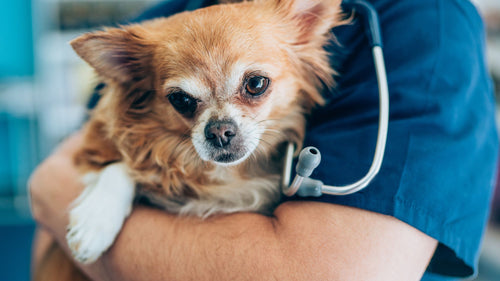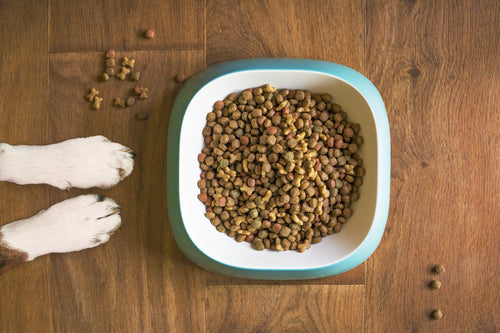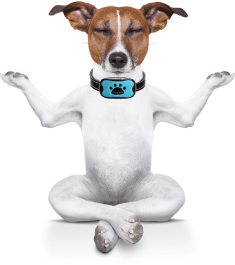Overweight Dog: Causes of Obesity in Dogs, Treatment and Prevention
Obesity in dogs is currently quite common. Obesity is understood as an increase in body weight by 20% or more due to body fat.
Causes of Obesity in Dogs
Generally speaking, the main cause of dog obesity is the discrepancy between food intake and a dog's activity level. If the dog’s activity has slowed and the food intake has not changed in any way, then the accumulation of excess adipose tissue is inevitable.
In older animals, energy requirements are reduced by about 20-30% of the requirements of a young animal. Therefore, if your dog is over 7 years old, reconsider its nutrition: reduce the portion size, and eliminate or minimize the number of treats from the table. There is also special food for dogs with obesity.
There are several breeds that are believed to be predisposed to obesity. Typically, beagles, labradors, cocker spaniels, long-haired dachshunds, and basset hounds have this problem.
Castration is also considered to be a predisposing factor for obesity in dogs. However, it is worth noting that here we are talking about a decrease in activity, therefore, if the dog is not overfed, then it will not face this problem.
Click here to read about advantages and disadvantages of dry and wet food for dog.
Risk Factors for Overweight in Dogs?
Causes associated with various diseases:
o Diabetes mellitus;
o Hyperadrenocorticism;
o Hyperthyroidism.
Behavioral:
o Fear;
o Depression;
o Hierarchy (taking food from another animal);
o Food picking / coprophagia.
Environmental Factors:
o Overfeeding by the owner;
o Lack of places for exercise (walking);
o Elderly age / disability of the owner
Previous large-scale studies have shown that the social aspect, namely the owner factor, plays a key role in the emergence of obesity. Below is a list of reasons:
- Humanizing the dog
- Frequent change of food with the motivation that the dog is bored with it
- A large number of delicacies (this is especially true for small breeds, for which even a piece of cheese the size of a phalanx of a finger will already be a lot by their weight)
- Failure to understand that begging and hunger are two different things
- Subjective belief that the given breed of dogs is overweight, making them nicer. Usually the owners of Welsh Corgi, Bulldogs, Bull Terriers sin this way
- A situation where the dog is fed by several family members (in some cases, people, without saying a word, treat the dog with various delicacies “while no one sees it”
- Fee walking of dogs in summer cottages, in private houses, where the animal can hunt or visit neighbors and treat themselves
Regardless of the factors, excess body weight in dogs occurs due to the fact that the balance between energy intake and its expenditure is disturbed. Energy consumption occurs for basic metabolism (heat release, physiological processes) and physical activity.

Symptoms of Obesity in Dogs
How do you know if your pet is obese? In advanced cases, any person will recognize the problem. Such dogs do not have a waist, the belly sags, there is a significant fat pad in the area of the tail root, and the ribs cannot be felt, even with effort.
In this case, the following symptoms may be observed:
- Shortness of breath with minimal activity
- Intolerance to weight
- Lameness
- Extremely low activity
However, in the early stages, the owner may not realize that his dog is already overweight.
Two systems for assessing this condition of obesity are officially recognized in the world: five-point and nine-point
On a nine-point system, it is easier to assess the degree of deviation in body weight:
6-9 points - Overweight animals (10-40%). The last degree has no upper limit. For example, two obese dogs of the same size and bone structure may have different weights, but each can be rated 9 points.
6 points - Ribs can be felt, but they are under a little excess fat. The waist is visible but not pronounced. The belly is slightly tucked up.
7 points - You can still feel the ribs under the fat layer, but with difficulty. Deposits of fat above the tail and on the lower back are already noticeable. There is no waist. The belly is not tucked up.
8 points - Ribs are not palpable under the fat layer. Very noticeable fat deposits at the base of the tail and loin. There is no waist, and the belly either sags or forms a straight line with the chest.
9 points - The belly is very large. Fat deposits in the tail and lower back are visible even when viewed from afar. There is no waist.

Obesity in Dogs Health Risks
The consequences of obesity in dogs can be serious. Here are the main diseases that often accompany obesity:
- Metabolic disorders (hyperlipidemia, insulin resistance, glucose intolerance, complications of anesthesia)
- Endocrine pathologies (hyperadrenocorticism, hypothyroidism, diabetes mellitus, insulinomas, pituitary adenoma)
- Functional disorders (shortness of breath, hypertension, obstructed labor, intolerance to stress and heat, diseases of the musculoskeletal system, in particular joints)
- Cardiovascular diseases
- Tendency to cancer
In addition to the above diseases, it is worth noting the fact that overweight dogs live on average 20% less than their well-conditioned brethren.
Treating Obesity in Dogs
The first and most important step towards treatment in dogs is to acknowledge the fact there is a problem. Only by realizing the seriousness of the situation and the possible accompanying problems can you help the animal. Recognizing this fact, the owner will ask himself the question: what do I do to help? Unfortunately, drug therapy is not provided in cases of obesity. There are no drugs that could affect remedy the situation. The only treatment that really works is diet therapy. In order to compose a diet for an obese dog, you first need to determine the ideal weight of the pet. Your veterinarian will help you with this.
Optimal Dog Weight
Each breed has its own weight range. But even in representatives of the same breed, gender and age may differ. Most healthy dogs reach their ideal weight at 12-18 months. However, some dogs are overfed from adolescence, and by the age of one and a half they are usually already overweight.
According to the same system, which was mentioned above, 5 points are dogs in perfect condition. In such animals, the ribs are well felt, but at the same time they are not visible. The dog's belly should be tucked up, and when viewed from above,a waist of normal proportions should be visible.
It is worth noting that in order to assess the condition of puppies, the modern system does not normally have a sagging belly. In addition, when overfeeding, puppies spend excess energy not in body fat, but in growth. For large and giant breeds, growing too quickly can cause problems with the musculoskeletal system, so it is imperative not to overfeed these dogs.

Dog Obesity Diet
There are two ways to lose weight. Let's talk about each of them separately.
There are two ways to lose weight. Let's talk about each of them separately.
The first way to lose weight is by feeding your dog 60% of the normal portion. Usually, this path is chosen by pet owners when they want to reduce the weight of their pet themselves, without the help of a doctor. In this case, the dog's daily feed portion is reduced by 40%. There are obvious disadvantages to this path. First, there is the constant feeling of hunger in the dog. The second, more serious disadvantage, is that thoughtlessly reducing the amount of feed can also reduce the amount of minerals and water-soluble vitamins your dog receives. In addition, if the feed initially contains a small amount of protein, then with a decrease in the amount of feed, the protein, as well as essential amino acids, may be completely deficient. This may cause your pet serious health problems.
The second way to lose weight is a reduction diet. At the moment, this method is considered the most effective and safe for animals. In this case, there is a decrease in the calorie content of the diet. This takes into account the amount of calories that the dog received earlier. Here, of course, you will need the help of a veterinarian nutritionist. His task is to make sure that although the calorie content is reduced, all the necessary nutrients are supplied at the same rate. This diet has no disadvantages.
The Basic Principles of the Reduction Diet:
- Proteins are preferred (low energy absorption, good satiety, reliable results)
- The amount of fiber increases (fiber is responsible for that “full” feeling)
- The amount of carbohydrates in the diet is reduced
- The amount of fat in the diet is reduced
In order to assess the effect of diet therapy, the dog must be weighed regularly (once every 1-2 weeks). Weighing must be carried out on the same scales and under the same conditions (for example, always in the morning on an empty stomach). Keep a notebook to record your dog's body weight.
The ideal weight loss is 1.5% of the dog's weight per week. Some dogs may lose weight a little more slowly, but if the weight stands still or decreases by less than 1% per week, then this is a reason to revise the diet and further reduce calories.
Do not forget that success depends not only on how much energy the dog consumes, but also on how much it uses. In other words, the importance and necessity of physical activity cannot be underestimated. At first, it will be difficult for a pet to walk for a long time, so the duration of walks should be increased gradually, literally by 10 minutes a week, if there is a lot of excess weight. The optimal duration of walks is at least two hours a day on a leash in measured steps. And the most effective aid in weight loss in dogs is a water treadmill or swimming.

In conclusion, I would like to add that, even having achieved the desired result, you cannot relax. If your dog is prone to gaining excess weight, remember a few rules to apply in daily life:
- Feeding time should be fixed;
- Do not disturb your dog while it is eating. No need to persuade her or stand over her. Healthy dogs should not be encouraged to eat;
- If the dog is capricious and picky about food for no objective reason, there is no need to offer her variety - this can lead to further whims;
- Do not add treats to the feed to make it tastier, because they also have their own calorie content. So, for example, 10 grams of dried meat is equal in calories to 40 grams of raw meat;
- Don't use food to make your dog happy. Do not give treats out of guilt - for example, when the dog has been alone for a long time;
- Don't be alarmed if your dog is not eating the feed.
Obesity in dogs is a serious medical condition that shortens the life of your pet. Therefore, remember that the best way to fight obesity is to prevent it. Therefore, long walks, active games and training are the best way to demonstrate love and care, rather than an extra piece of food from your table.









